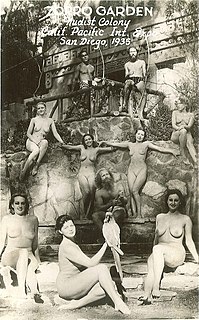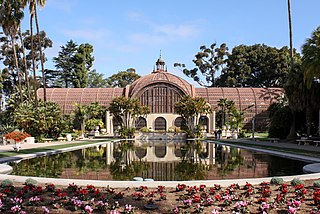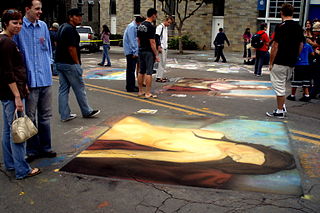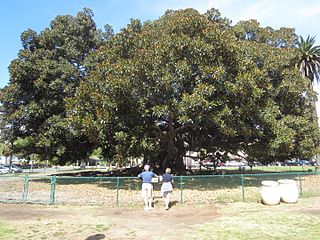
The Panama–California Exposition was an exposition held in San Diego, California, between January 1, 1915, and January 1, 1917. The exposition celebrated the opening of the Panama Canal, and was meant to tout San Diego as the first U.S. port of call for ships traveling north after passing westward through the canal. The fair was held in San Diego's large urban Balboa Park.
State Route 163 (SR 163), or the Cabrillo Freeway, is a state highway in San Diego, California. The 11.088-mile (17.844 km) stretch of the former US 395 freeway runs from Downtown San Diego just south of an interchange with Interstate 5 (I-5), extending north through historic Balboa Park and various neighborhoods of San Diego to an interchange with I-15 in the neighborhood of Miramar. The freeway is named after Juan Rodríguez Cabrillo, the first European to navigate the coast of present-day California.

Balboa Stadium is an American football and soccer stadium in San Diego, California. Just east of San Diego High School, the original stadium was built in 1914 as part of the 1915 Panama–California Exposition, also in Balboa Park, with a capacity of 15,000. A horseshoe design that opened to the south, it was designed by the Quayle Brothers architectural firm and originally called City Stadium.

Zorro Garden Nudist Colony was an attraction at the 1935-36 Pacific International Exposition in Balboa Park in San Diego, California. It was located in Zorro Garden, a sunken garden originally created for the 1915-16 Panama-California Exposition. Billed as a nudist colony, it was populated by hired performers rather than actual practicing nudists. The women wore only G-strings; the men wore loincloths or trunks. The participants lounged around in their "colony", played volleyball and other games, and performed a quasi-religious "Sacrifice to the Sun God" five times a day. Fair attendees could pay for admission to bleacher-type seats, or they could peek through knotholes in a wooden fence for free. On August 27, 1936, the colony closed, allegedly "after an argument with Exposition officials about finances."

George White Marston was an American politician, department store owner, and philanthropist. Marston was involved with establishing Balboa Park, the San Diego Public Library System, and San Diego Presidio Park. His contributions to San Diego earned him the affectionate title of "San Diego's First Citizen."

Balboa Park Gardens are cultivated areas of Balboa Park in San Diego, California.

The California Pacific International Exposition was an exposition held in San Diego, California during May 29, 1935–November 11, 1935 and February 12, 1936–September 9, 1936. The exposition was held in Balboa Park, San Diego's large central urban park, which had also been the site of the earlier Panama-California Exposition in 1915.

Katherine Olivia "Kate" Sessions was an American botanist, horticulturalist, and landscape architect closely associated with San Diego, California, and known as the "Mother of Balboa Park."

University Heights is a neighborhood in Central San Diego, California centered on Park Boulevard and Adams Avenue. University Heights is bounded on the west and north by the edge of the mesa, the southern boundary is Lincoln Avenue, and the eastern boundary is Boundary Street along the western edge of Interstate 805. The area is filled with a number of restaurants, coffee shops, boutiques, and artist studios primarily on Park Boulevard and Adams Avenue. Live entertainment can be found most nights. Adjacent to Hillcrest, Normal Heights and North Park, additional restaurants, bars, coffee shops, and night clubs are within easy reach.

The culture of San Diego, California is influenced heavily by American and Mexican cultures due to its position as a border town, its large Hispanic population, and its history as part of Spanish America and Mexico. San Diego's longtime association with the U.S. military also contributes to its culture. Present-day culture includes many historical and tourist attractions, a thriving musical and theatrical scene, numerous notable special events, a varied cuisine, and a reputation as one of America's premier centers of craft brewing.

Naval Medical Center San Diego (NMCSD), also known as Bob Wilson Naval Hospital and informally referred to as "Balboa Hospital", or “The Pink Palace” is a technologically advanced Navy medical treatment facility. Located within the grounds of Balboa Park in San Diego, the hospital has played a role in the history of San Diego for more than 100 years. The goal has remained constant, to provide the finest medical care in a family-centered care environment to operational forces, their families, and veterans. Organizationally, the hospital is first and foremost a military command.

San Diego Art Institute is located in San Diego, California, US. The San Diego Art Institute was initially founded in 1941 as the San Diego Business Men's Art Club. In 1950 the name was changed to the San Diego Art Institute, and three years later women were allowed membership into the organization.

Balboa Park is a 1,200-acre (4.9 km2) historic urban cultural park in San Diego, California, United States. In addition to open space areas, natural vegetation zones, green belts, gardens, and walking paths, it contains museums, several theaters, and the San Diego Zoo. There are also many recreational facilities and several gift shops and restaurants within the boundaries of the park. Placed in reserve in 1835, the park's site is one of the oldest in the United States dedicated to public recreational use. Balboa Park is managed and maintained by the Parks and Recreation Department of the City of San Diego.

The Japanese Friendship Garden, also known as Sankei-en is a twelve-acre Japanese garden located within Balboa Park in San Diego, California. It is an expression of friendship between San Diego and its Japanese sister city Yokohama that binds the two cultures to create a unique experience for visitors from all over the world; over 240,000 people from across the United States and the world visit the garden annually. Representing a new concept in the development of a Japanese garden outside Japan, the Japanese Friendship Garden is designed to present an atmosphere of elegant simplicity (shibui) and quiet beauty. The garden's naturalistic design is guided by the original principles/techniques of the Japanese garden while incorporating elements of the regional San Diego landscape and climate; in terms of features, the garden is well-known for its unique placement, sukiya-style buildings, koi ponds, and landscape exhibits. The Japanese Friendship Garden also hosts many local educational programs, activities, festivals, and horticultural classes that focus on the relationship between nature and Japanese culture.
Richard Smith Requa was an American architect, largely known for his work in San Diego, California. Requa was the Master Architect for the California Pacific International Exposition held in Balboa Park in 1935–36. He improved and extended many of the already existing buildings from an earlier exposition, as well as creating new facilities including the Old Globe Theater.

Zoro Garden is a 6-acre sunken garden within Balboa Park in San Diego, California. It is located between the Reuben H. Fleet Science Center and the Casa de Balboa. The name refers to the Persian mystic Zoroaster.

The California Quadrangle, California Building, and California Tower are historic structures located in Balboa Park in San Diego, California. They were built for the 1915–16 Panama-California Exposition and served as the grand entry to the Expo. The buildings and courtyard were designed by architect Bertram Goodhue. They were added to the National Register of Historic Places on May 17, 1974. They now house the Museum of Us.

The El Prado Complex is a historic district in Balboa Park in San Diego, California. The 13-acre (5.3 ha) complex includes 13 contributing buildings and one contributing structure. Most of the structures were built for San Diego's Panama-California Exposition of 1915–16 and were refurbished and re-used for the California Pacific International Exposition of 1935–36. The original architects were Bertram Goodhue and Carleton Winslow. The area was listed on the National Register of Historic Places in 1976.

The San Diego History Center is a museum showcasing the history of San Diego, located in the city's Balboa Park.

The Moreton Bay fig tree in San Diego's Balboa Park is one of the largest trees in California.




















